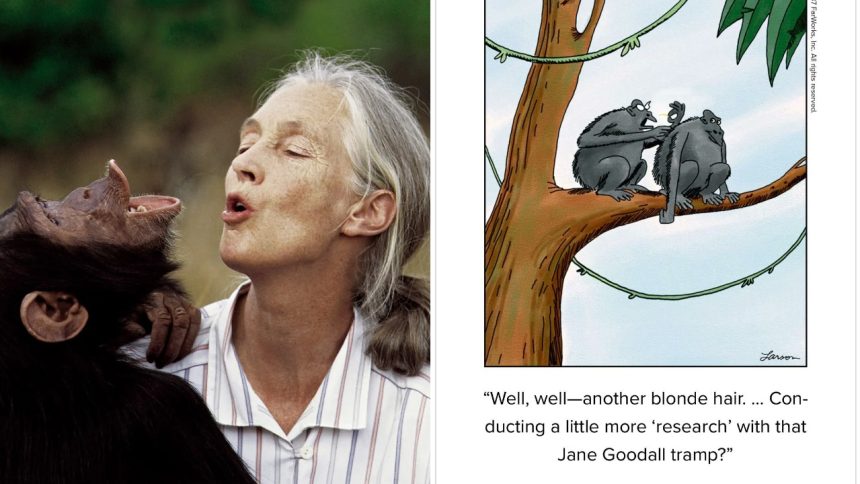It’s not every day that a single-panel cartoon sparks a controversy that leads to an unexpected friendship. Yet, that’s exactly what happened in 1987 when Gary Larson, the brilliantly quirky mind behind The Far Side, published a comic that seemed to insult the world-renowned primatologist Dr. Jane Goodall. The incident sparked immediate outrage from her institute, left Larson horrified, and set the stage for a reconciliation that nobody saw coming. The story of the “tramp” cartoon is a fascinating tale of how a misunderstanding, fueled by a misplaced sense of protection, ultimately resulted in a bond of mutual respect between two icons from seemingly different worlds.
The now-infamous cartoon, published in August 1987, depicted two chimpanzees in a tree. One of them, a female, is grooming the other and finds blonde hair on him. She then asks, “Well, well—another blonde hair… Conducting a little more ‘research’ with that Jane Goodall tramp?” Larson’s signature offbeat humor was on full display, but this time, it landed with a thud for some readers. The executive director of The Jane Goodall Institute was among those not amused. She sent a scathing letter to Larson’s syndicate, calling the cartoon an “atrocity” and “inexcusable,” and strongly implying that it was in incredibly poor taste to refer to the respected scientist in such a manner.
For Larson, who had a deep admiration for Goodall and her work, the reaction was devastating. He later wrote that he was “horrified,” not out of fear of being sued, but because offending Dr. Goodall was the last thing he had ever intended to do.
An Unlikely Friendship Following Far Side Controversy and a Chimpanzee’s Revenge
The twist in this story, however, is that Jane Goodall, who passed away recently, had not even seen the cartoon when her institute fired off its angry letter. She was away in Africa at the time. When she finally returned and was shown the comic, her reaction was the complete opposite of her staff’s. Rather than being offended, she found it funny. Goodall even expressed a sense of honor, noting, “I thought it was very funny. And I think if you make a Gary Larson cartoon, boy, you’ve made it.”
She understood the joke and recognized that Larson was not maliciously attacking her character. This marked the beginning of a genuine friendship between the scientist and the cartoonist. Goodall demonstrated her goodwill by writing the preface for Larson’s 1993 collection, The Far Side Gallery 5, and even licensed the controversial cartoon for T-shirts sold to benefit the Jane Goodall Institute, turning the initial offense into a fundraising success.
In 1987, newspapers ran this Far Side comic.
The director of the Jane Goodall Foundation wrote an angry letter over it, but Jane Goodall herself loved it.
“Wow! Fantastic! Real fame at last! Fancy being in a Gary Larson cartoon!”
She later wrote a forward for a Larsen book. pic.twitter.com/nOJPTsdsPG
— Mike Beauvais (@MikeBeauvais) October 1, 2025
The story has a bizarre and somewhat poetic postscript. In 1988, Larson accepted an invitation to visit Goodall’s research facility in Gombe National Park. During his visit, he encountered a chimpanzee named Frodo, whom Goodall described as a bully. In an ironic twist that seemed straight out of a Far Side comic, Frodo—apparently unimpressed by Larson’s work—decided to pounce on the cartoonist. Larson was left with several scratches and bruises from the encounter, a physical reminder of his strange and wonderful journey from being a perceived detractor to an accepted guest in Goodall’s world.
The entire episode stands as a testament to the power of context and the importance of intent in humor. What one person viewed as an obscenity, the intended subject found to be a hilarious badge of honor. The “controversy” ultimately wasn’t between Goodall and Larson, but rather between a protective institution and a misunderstood artist. Their story highlights how a willingness to see the humor in a situation can bridge even the widest of gaps, leading to a collaboration that supported the very work the cartoon was thought to mock. It’s a reminder that sometimes, the best way to resolve a conflict is to simply get the joke.



